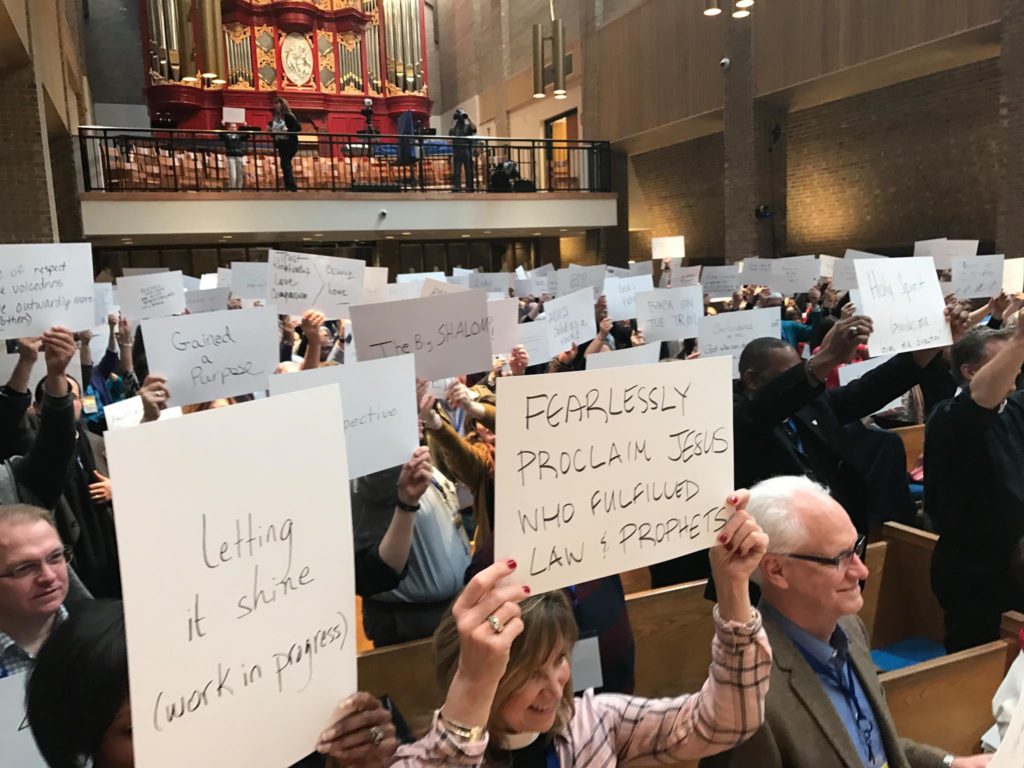At the recent Evangelism Matters conference in Dallas, TX, the Rev. Canon Stephanie Spellers gave a presentation encouraging attendees to write up “cardboard testimonies.” These cardboard signs present a before-and-after story—one side shows life before transformation with the other side showing life after transformation. You can see some of the results here:

The Rev. Emily J. Schnabl, rector of St. Christopher’s, Midwest City, Oklahoma, attended Evangelism Matters and was inspired by the cardboard testimonials to try the exercise in the church she serves. Here is her brief story.
Go and tell John. . .the blind receive their sight, the lame walk. . .the dead are raised.” Those words from the Gospel lesson appointed for the Third Sunday of Advent jumped out at me. I had been thinking about how to implement the cardboard testimony exercise that Canon Stephanie Spellers led us through on the second morning of the Evangelism Matters conference, and I thought I had found the right Sunday to do it. Armed with two packages of cardstock (half-priced that day—surely a sign of favor), and every Sharpie and marker I could find in the building, I used the exercise during the traditional sermon time at both our 8:00 a.m. and 10:30 a.m. services on Sunday morning.
I told my parishioners that this was an exercise attendees had gone through at the conference, and then I talked about how our baptismal vows include the responsibility to “go and tell.” We have an explicit responsibility, even in the midst of a frightening world, to talk about the goodness of God that is especially found when we are together. As Canon Spellers had instructed us at the conference, I asked parishioners to write down a struggle they had experienced in their lives on one side of the cardstock, and how God had transformed that struggle on the reverse side.

They filled out their cards and then I asked them to move around (gasp) and find someone to share their story with. Our congregation is in the midst of a transition—we’re growing, which is great, but many folks don’t know each other yet. Although I didn’t tell them to talk with people they didn’t know, I saw that many people sought out people outside of their normal circles, which was gratifying. Some were willing to tell their stories of struggle out loud—stories about money worries or trying to save other people and failing or trying to sort things out alone. And all of them offered glimpses of how God had entered into those situations and offered comfort, peace, and community.
This particular Sunday was also our pledge ingathering day, and I asked people to place their pledge cards in the offering basket in front of the altar, along with their story cards, so we could offer off of these things as part of our Eucharistic celebration. This was a very moving moment. The cards were scattered around our Advent altar installation—an empty manger draped with purple, an offering of hope for the coming of Jesus.
After both services were over, I walked around the altar, reading the testimony cards. People willingly shared some of the hardest struggles in their lives. A number of parishioners wrote about cancer or the death of a loved one; some named difficult family relationships as struggles. On the flip side, they testified to their experience of God, sometimes in spiritual experiences but also in concrete experiences of community.
I can’t say what the long-term impact of this exercise may be on our community or in the personal lives of those who participated, but I know I saw a lot of life and energy in the Parish Hall after church that morning. Telling our stories of testimony to each other is just one step in the lifelong process of helping us understand that the church—and the sharing of the good news of God in Christ—belongs to everyone, not just clergy. For that, I am thankful—and I am ready and willing to take the time to “go and tell.”



